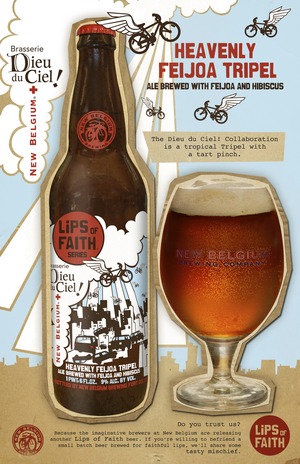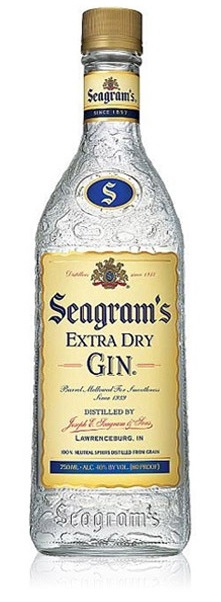 TRADITIONAL BELGIAN tripels are remarkable for many reasons, not least among them the complexity they extract from a modicum of ingredients. Heavenly Feijoa, a recent Lips of Faith collaboration between New Belgium Brewing and Dieu du Ciel!, is the antithesis of such economy. With hibiscus, feijoa juice, pungent New Zealand hops, and even a small dose of black malt, this 9.4% ABV tripel risked being a garish waste of ‘artisanal’ ingredients. Yet all these strange tweaks share a common thread, revealing the conscientious craftsmanship that drives this series—a refreshing reminder after a string of seemingly haphazard disappointments—and the results are rather charming.
TRADITIONAL BELGIAN tripels are remarkable for many reasons, not least among them the complexity they extract from a modicum of ingredients. Heavenly Feijoa, a recent Lips of Faith collaboration between New Belgium Brewing and Dieu du Ciel!, is the antithesis of such economy. With hibiscus, feijoa juice, pungent New Zealand hops, and even a small dose of black malt, this 9.4% ABV tripel risked being a garish waste of ‘artisanal’ ingredients. Yet all these strange tweaks share a common thread, revealing the conscientious craftsmanship that drives this series—a refreshing reminder after a string of seemingly haphazard disappointments—and the results are rather charming.
The beer’s looks are traditional, if a little underwhelming: golden, a little hazy, and with a thin layer of white head but no lasting bubbles. The aroma blends ginger snap and lemon with an unexpected twist of tart berry coming from the feijoa juice, presumably bolstered by almost winey Nelson Sauvin hops. That bouquet presages a surprisingly tart, forward-focused flavor that shifts its focus from citrus early to berries late. Yeast and malt are more apparent in between, though more for the other flavors’ waning than their own waxing. Marked as Best Before March 2014, the beer’s has clearly smoothed considerably since its bottling—at that time a spicier midsection and more assertive effervescence would likely have helped keep its distinctive corners pinned up neatly. Carbonation remains fairly high, though, with small and creamy bubbles carrying smoothly from front to back and leaving the finish fairly clean, if not especially lasting. The beer’s body is likely a little fuller than most tripels, too, and the juice likely didn’t ferment out quite as cleanly as the traditional adjunct of candi sugar. Perhaps that aging has also diminished the alcohol presence, since a 9.4% ABV is rarely so unobtrusive, especially in a tripel. The ultimate balance is well-struck between mild titillation and simply good refreshment.
Served: 750 ml bottle best before March 2014
Rating: 85

 TRADER JOE’S VINTAGE ALES are one of the beer world’s happiest and surely most random happenstances. Each year a clutch of these dull brown 750 ml bottles descends on TJ endcaps everywhere, bolstered by brightly hand-drawn signs crowing ‘$4.99!’, ‘Can be aged for years!’, and other impassioned appeals to our urge to stock up. Such tactics are usually worthy of great skepticism, but in this case the enthusiasm is at least partially merited since the Vintage Ale is brewed and bottled by none other than Quebec’s Unibroue,
TRADER JOE’S VINTAGE ALES are one of the beer world’s happiest and surely most random happenstances. Each year a clutch of these dull brown 750 ml bottles descends on TJ endcaps everywhere, bolstered by brightly hand-drawn signs crowing ‘$4.99!’, ‘Can be aged for years!’, and other impassioned appeals to our urge to stock up. Such tactics are usually worthy of great skepticism, but in this case the enthusiasm is at least partially merited since the Vintage Ale is brewed and bottled by none other than Quebec’s Unibroue, 
 A SELF-DESCRIBED lighter companion to their high-gravity tripel (i.e.
A SELF-DESCRIBED lighter companion to their high-gravity tripel (i.e.  WHETHER THE 17 should be a Belgian Strong Dark or a Quadrupel is frankly immaterial: whatever its name, it is a beer of profound density and balance. Recognizably Unibroue, loosely a furthering of their Trois Pistoles, but with the added complexity of spices and oak-aging. The head is lingering, bright and faintly acerbic; the beer itself powerfully malty, but balanced sufficiently by the relatively high IBU of 35. Blending of head and liquid make for a mocha-like concoction that’s almost creamy, but never too sweet. (And, for what it’s worth, given the 17’s prominence of spice and malt instead of fruit, the Belgian Strong Dark is the better category after all.) A slow-sipping triumph even this young, at peak maturity it will rival better ports as a pairing for a cheese dessert plate. A slow-sipping triumph even this young, at peak maturity it will rival better ports as a pairing for a cheese dessert plate.
WHETHER THE 17 should be a Belgian Strong Dark or a Quadrupel is frankly immaterial: whatever its name, it is a beer of profound density and balance. Recognizably Unibroue, loosely a furthering of their Trois Pistoles, but with the added complexity of spices and oak-aging. The head is lingering, bright and faintly acerbic; the beer itself powerfully malty, but balanced sufficiently by the relatively high IBU of 35. Blending of head and liquid make for a mocha-like concoction that’s almost creamy, but never too sweet. (And, for what it’s worth, given the 17’s prominence of spice and malt instead of fruit, the Belgian Strong Dark is the better category after all.) A slow-sipping triumph even this young, at peak maturity it will rival better ports as a pairing for a cheese dessert plate. A slow-sipping triumph even this young, at peak maturity it will rival better ports as a pairing for a cheese dessert plate.



